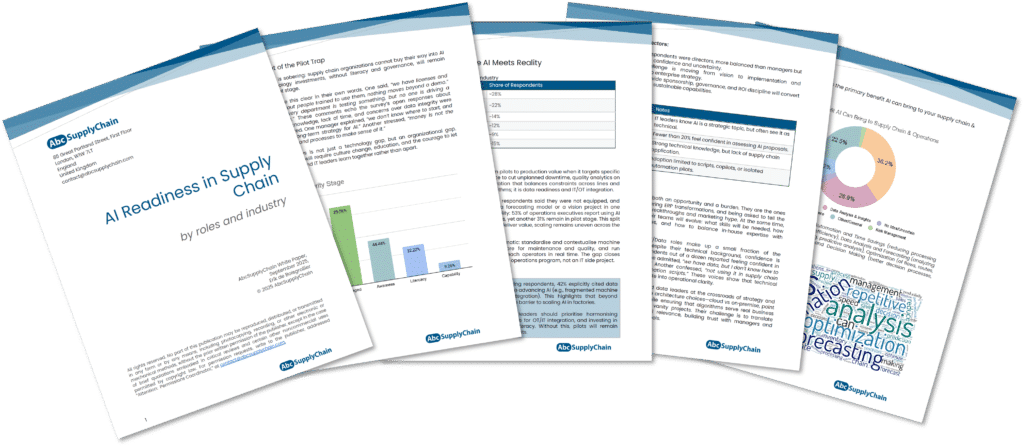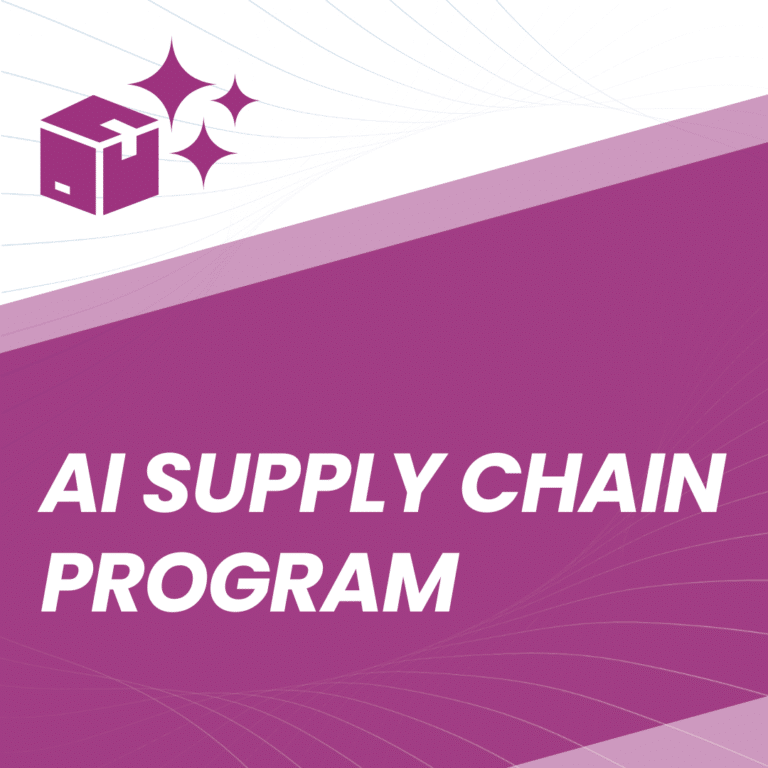Nearly 1,000 supply chain professionals responded to our survey on Artificial Intelligence in the Supply Chain. The results are clear: AI is recognized as essential, yet few teams feel truly ready to adopt it effectively. This gap between visible enthusiasm and the real capacity to deploy AI in concrete ways paints a contrasted landscape. Professionals know they must act, but they still lack clear markers to move forward.
To compile the key takeaways, Erik, our COO, former Big Data Manager and AI entrepreneur, prepared an exclusive 30-page white paper (in English): AI Readiness in Supply Chain by Roles and Industries. This document offers a detailed analysis of perceptions, obstacles, and opportunities by role and industry, and charts pragmatic action paths for the years ahead.

1. From awareness to application of intelligence in the Supply Chain: a real gap exists
Most professionals surveyed acknowledge that AI is now central to their role. Yet when it comes to assessing or implementing a concrete project, many admit they do not feel equipped. This mismatch between awareness of change and capacity to act creates a tension that slows large-scale adoption.
- Awareness vs capacity: 97% say AI is part of their role, but only ~20% feel capable of evaluating an AI project.
- Fragmented efforts: 55% report isolated, siloed initiatives with no overarching strategy.
- Urgent needs: understand what AI can and cannot do, choose the right tools, and turn data into decisions.
- Main obstacles: lack of knowledge, fragmented data, lack of time, and leadership alignment.
AI is therefore not only a technology question: it is above all about culture, skills, and governance.
2. Maturity differs by role
Each supply chain function faces specific challenges when adopting AI. Managers, directors, IT leaders, and planners do not approach these tools in the same way, and each expresses distinct needs and concerns. The study shows that confidence is not evenly distributed, and that barriers are both psychological and organizational.
- Managers: aware of the stakes but not very confident (only 18% feel capable). Their top need is learning to interpret AI outputs for daily decisions.
- Directors: torn between strategic vision and uncertainty. Their challenge is turning isolated pilots into a coherent, enterprise-wide strategy.
- IT/Data leaders: paradoxically, they also lack confidence. Their mission is to translate technology into clear operational decisions.
- Planners: directly exposed to forecasting models, but held back by low trust in dashboards.
- Procurement & Logistics: still very exploratory, with uses mainly limited to chatbots or document automation.
3. A view by industry
AI maturity levels are not uniform. Each sector presents specific opportunities as well as its own blockers related to data, processes, and internal culture. This diversity shows that AI is not a universal solution: adoption depends on readiness, data quality, and team training.
- Manufacturing: promising projects (computer vision, predictive maintenance) but held back by poorly integrated data.
- Retail & Distribution: high potential (demand sensing, dynamic pricing) but data too fragmented.
- Healthcare/Pharma: use cases around traceability and cold chain, still at pilot stage.
- Luxury & Fashion: many experiments, but a need for practical training for merchandisers and planners.
- Food & Beverage: still at the descriptive stage, without true predictive capabilities.
4. The pilot trap
Today, most companies are stuck in a multiplication of pilots without a global vision. They test forecasting modules, chatbots, or reporting automations, yet these initiatives remain local and disconnected. The problem is not only the lack of tools, but the absence of strategy and governance to turn these tests into durable levers.
The real challenge is not buying more technology: it is developing skills and shared governance to scale.
Conclusion
This study reveals a paradox: AI is viewed as essential in supply chain, yet most initiatives remain stuck at the exploratory stage. Teams know they must move forward, but encounter structural and cultural barriers. To progress, three priorities emerge:
- invest in team training,
- identify replicable use cases,
- establish cross-functional governance.
You can explore all detailed results in our white paper.
What is the main gap in AI adoption in supply chains?
97% of professionals acknowledge AI is part of their role, but only ~20% feel capable of evaluating a project. Awareness exists, capability is lacking.
What are the major obstacles to Artificial Intelligence adoption?
Lack of knowledge, fragmented data, lack of time, and insufficient leadership alignment.
How does maturity vary by role?
Managers lack confidence, directors seek a strategy, IT/Data struggle to translate tech, planners doubt forecasts, Procurement & Logistics remain exploratory.
What differences are seen across industries?
Manufacturing: data hurdles. Retail: potential but fragmented data. Pharma: pilots in traceability. Luxury & Fashion: experimentation and training needs. Food & Beverage: descriptive uses.
Why are AI pilots a problem in supply chains?
They multiply without a global vision. Without governance and strategy, they remain local and do not deliver durable transformation.
What are the three priorities to make progress?
Train teams, identify replicable use cases, and implement cross-functional governance.


